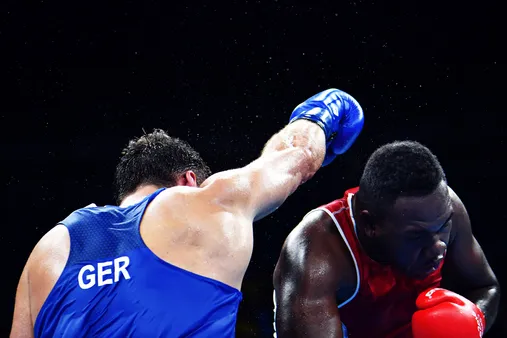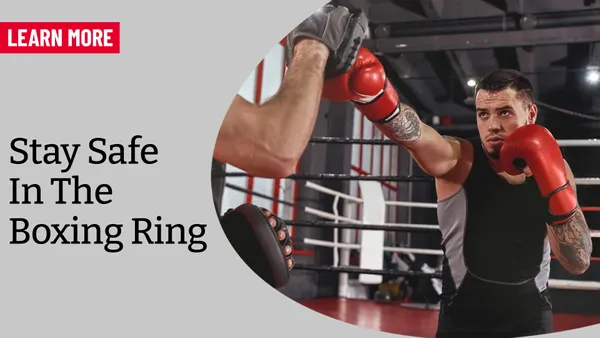Table of Contents
In the realm of boxing, where adrenaline and power collide, the risk of injuries is an unavoidable reality. Boxers endure grueling training sessions and intense matches, making them prone to various physical ailments. Understanding "The most common boxing injuries and how to prevent them" is paramount for safeguarding the well-being of fighters. At Kizworld, we delve into the prevalent injuries in boxing, exploring their causes and providing effective strategies to minimize risks. Embark on this comprehensive guide to ensure a safer and more fulfilling boxing experience.
The Most Common Boxing Injuries and How to Prevent Them
I. Common Boxing Injuries and Prevention Techniques
Common Boxing Injuries and Prevention Techniques
Head Injuries
- Concussion: A temporary loss of consciousness or mental function caused by a blow to the head.
- Brain hemorrhage: Bleeding within the brain caused by a blow to the head.
- Brain edema: Swelling of the brain caused by a blow to the head.
Prevention: Wear a properly fitted headgear during training and competition. Avoid taking unnecessary risks in the ring. Learn to tuck your chin and roll with punches. Strengthen your neck muscles by performing neck exercises.
Hand and Wrist Injuries
- Boxer's fracture: A break in one of the small bones in the hand caused by punching a hard object.
- Carpal tunnel syndrome: A condition that causes pain and numbness in the hand and wrist.
- Tendonitis: Inflammation of the tendons in the hand and wrist.
Prevention: Wear properly fitted boxing gloves during training and competition. Use wraps to protect your hands and wrists. Avoid punching hard objects. Stretch your hands and wrists before and after training. Strengthen your forearms and wrists by performing forearm and wrist exercises.
Foot and Ankle Injuries
- Sprained ankle: A tear in the ligaments that hold the ankle bones together.
- Plantar fasciitis: A condition that causes pain in the heel and arch of the foot.
- Achilles tendonitis: Inflammation of the Achilles tendon, which connects the calf muscles to the heel bone.
Prevention: Wear properly fitted boxing shoes during training and competition. Warm up your feet and ankles before training. Stretch your feet and ankles after training. Strengthen your calf muscles and Achilles tendons by performing calf raises and Achilles tendon stretches.
Treatment for Boxing Injuries
The treatment for boxing injuries will depend on the severity of the injury. Some injuries, such as a concussion, may require hospitalization. Other injuries, such as a boxer's fracture, may require surgery. In most cases, boxing injuries can be treated with rest, ice, compression, and elevation.
Safety Precautions in Boxing
- Always wear proper safety gear, including a headgear, gloves, wraps, and mouthguard.
- Train with a qualified boxing coach who can teach you proper technique and safety precautions.
- Spar with partners of similar size and experience.
- Listen to your body and stop training if you are feeling pain.
By following these safety precautions, you can help to reduce your risk of injury in boxing.
Related Posts:
- How to Create a Personalized Boxing Training Schedule
- Unleashing the Benefits of Boxing: A Full-Body Workout for Enhanced Fitness
- Ignite Your Fitness Journey: A Comprehensive Boxing Fitness Routine
II. Protective Gear: Essential Shields against Impact
Protective Gear: Essential Shields against Impact
In the ring, boxers subject their bodies to intense forces that can result in a wide array of injuries. Protective gear plays a crucial role in safeguarding combatants from harm, minimizing the risk of both minor and severe trauma.
Headgear is paramount in boxing, serving as the primary defense against head and brain injuries. It effectively cushions blows to the face, reducing the impact of punches and safeguarding the skull, brain, and facial bones. Look for headgear that fits snugly, providing full coverage and ample cushioning.
Boxing gloves are another essential piece of protective gear. They serve to protect both the boxer's hands and their opponent's face and head. Select gloves that are appropriate for your weight class and provide adequate padding in the knuckles and wrist areas.
Mouthguards are small, custom-fitted appliances worn inside the mouth to protect the teeth and gums from impact. They play a vital role in preventing injuries such as chipped, cracked, or knocked-out teeth, as well as cuts to the lips and tongue.
III. Key Benefits of Protective Gear in Boxing:
- Head injuries: Protective gear such as headgear, mouthguards, and face shields help to minimize the risk of concussions, skull fractures, and other serious head and brain injuries.
- Hand and wrist injuries: Gloves help to absorb the impact of punches, reducing the risk of hand and wrist fractures, dislocations, and tendon injuries.
- Foot and ankle injuries: Boxing shoes provide support and stability, helping to prevent ankle sprains and foot injuries.
Additional Gear for Enhanced Protection
Besides the essential safety gear discussed above, several additional items can further enhance a boxer's protection.
Hand wraps, worn beneath boxing gloves, offer extra support for the hands and wrists, reducing the risk of sprains and strains. Look for hand wraps that are made of high-quality material and provide adequate length for proper wrapping.
Groin protectors are crucial for safeguarding the groin area from punches and kicks. They are designed to absorb impact and shield the sensitive tissues in the groin region.
Chest protectors are commonly used in training and sparring to minimize the impact of punches to the chest and ribcage. They provide additional cushioning and help prevent bruises, muscle strains, and other chest injuries.
In conclusion, protective gear is an indispensable component of boxing safety. Headgear, gloves, mouthguards, and additional gear such as hand wraps, groin protectors, and chest protectors play a vital role in safeguarding boxers from a range of injuries. By prioritizing safety and using appropriate protective gear, boxers can significantly reduce the risk of harm and enjoy the sport safely.
IV. Related Post:
- The Most Common Boxing Injuries and How to Prevent Them
- Types of Boxing Injuries
- Treatment for Boxing Injuries
V. Effective Training Methods to Minimize Risks
Effective Training Methods to Minimize Risks
Incorporating effective training methods is essential for minimizing the risks associated with boxing. These methods prioritize safety, technique, and conditioning:
- Warm-up and Cool-down: Begin each training session with a dynamic warm-up to prepare the body for the rigors of boxing. Follow each session with a cool-down to promote recovery and prevent muscle soreness.
- Technical Proficiency: Master the fundamental techniques of boxing, including proper stance, footwork, punches, and defense. This will help avoid bad habits that can lead to injuries.
- Conditioning and Strength Training: Engage in regular conditioning exercises to improve cardiovascular health, agility, and muscular endurance. Strength training builds muscle mass, which helps protect joints and absorb impact.
- Sparring Safety: When engaging in sparring, wear appropriate protective gear, including headgear, gloves, and mouthguards. Ensure that sparring partners are of similar skill and experience levels.
- Recovery and Rest: Allow adequate time for rest and recovery between training sessions and fights. This helps prevent overtraining and injuries while promoting optimal performance.
In addition to these general training methods, boxers can adopt specific techniques to reduce the risk of particular injuries:
Injury | Preventive Techniques |
|---|---|
Head Injuries: | Wear proper headgear, master defensive techniques, avoid reckless punching, and engage in regular neurological assessments. |
Hand and Wrist Injuries: | Use appropriate hand wraps, strengthen the wrists and forearms, and avoid punching hard objects. |
Foot and Ankle Injuries: | Wear supportive footwear, warm up properly, and strengthen the foot and ankle muscles. |
By adhering to these effective training methods and techniques, boxers can significantly minimize the risks of injuries while enjoying the physical and mental benefits of the sport.
Refer to our detailed guides on boxing exercises, speed and agility training, and boxing equipment for more in-depth insights.
VI. Lifestyle Adjustments for Optimal Recovery and Injury Avoidance
Lifestyle Adjustments for Optimal Recovery and Injury Avoidance
Nutritional Considerations
- Maintain a Balanced Diet: Prioritize a diet rich in fruits, vegetables, whole grains, and lean proteins to support overall health and recovery.
- Hydrate Adequately: Stay hydrated by consuming plenty of water throughout the day to aid in muscle recovery and prevent dehydration.
- Consume Anti-Inflammatory Foods: Incorporate foods with anti-inflammatory properties, such as berries, leafy greens, and turmeric, to reduce inflammation and promote healing.
Related: The Best Boxing Supplements and Nutrition
Adequate Sleep
- Prioritize Quality Sleep: Aim for 7-8 hours of quality sleep each night to allow the body to repair and restore itself.
- Establish a Consistent Sleep Schedule: Maintain a regular sleep-wake cycle, even on weekends, to promote restful sleep and optimal recovery.
- Create a Relaxing Bedtime Routine: Engage in calming activities before bed, such as reading, taking a warm bath, or practicing relaxation techniques, to promote better sleep.
Related: How to Get Started with Boxing as a Beginner
Stress Management
- Practice Relaxation Techniques: Engage in activities that help manage stress, such as meditation, deep breathing exercises, or yoga, to reduce tension and promote relaxation.
- Maintain a Healthy Work-Life Balance: Strive for a harmonious balance between work, personal life, and leisure activities to prevent burnout and excessive stress.
- Seek Support from Loved Ones: Share your feelings and concerns with friends, family, or a therapist to gain emotional support and reduce stress levels.
Related: The Most Common Boxing Injuries and How to Prevent Them
Active Recovery
- Engage in Light Exercise: Perform low-impact activities like walking, swimming, or cycling on rest days to promote blood flow and aid in recovery.
- Stretching and Foam Rolling: Incorporate stretching and foam rolling into your routine to improve flexibility, reduce muscle tightness, and enhance recovery.
- Massage Therapy: Consider regular massage sessions to relieve muscle tension, improve circulation, and accelerate recovery.
Related: How to Learn the Basic Boxing Skills and Techniques
Injury Prevention
- Warm Up Properly: Always start your boxing session with a thorough warm-up to prepare your body for the intense workout.
- Use Proper Technique: Master the correct techniques for punching, footwork, and defense to minimize the risk of injuries.
- Wear Protective Gear: Utilize appropriate protective gear, including gloves, headgear, and mouthguards, to reduce the impact of blows and prevent injuries.